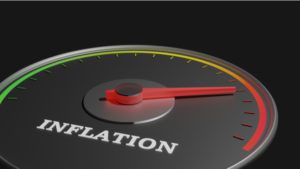Consumer prices are rising faster than they have for 30 years. The Bureau of Labor Statistics measure of CPI increased by 6.2% in October. All the descriptions of inflation as “transitory” seem to have disappeared in financial media. Colby Smith reports at Financial Times:
US consumer prices jumped in October at the fastest pace in three decades, as bottlenecks and other supply chain disruptions intensified and inflationary pressures spread further throughout the economy.
The consumer price index published by the Bureau of Labor Statistics on Wednesday rose 6.2 per cent in October from a year ago — the fastest annual pace since 1990 and a sharp increase from September’s levels of 5.4 per cent.
Month-over-month price gains accelerated, with a jump of 0.9 per cent amid what the BLS described as a “broad based” increase across a number of sectors. Between August and September, prices had risen a more moderate 0.4 per cent.
Driving the surge was an uptick in costs for energy as well as shelter, food, used cars and trucks and new vehicles, BLS said. The energy index rose 4.8 per cent from September, while the gasoline index popped 6.1 per cent. On an annual basis, these sectors are up 30 per cent and 50 per cent, respectively.
US president Joe Biden on Wednesday singled out rising energy costs as a primary driver of inflation and said it was a “top priority” to reverse the continuing trend.
“I have directed my National Economic Council to pursue means to try to further reduce these costs, and have asked the Federal Trade Commission to strike back at any market manipulation or price gouging in this sector,” he said in a statement.
He also implored Congress to pass his spending bill, saying “17 Nobel Prize winners in economics have said that my plan will ‘ease inflationary pressures’.”
In addition to higher energy prices, food prices also jumped 0.9 per cent over the month, with a 1 per cent rise in “food at home” costs.
Stripping out volatile items such as food and energy, prices rose 0.6 per cent for the month, well above the previous reading of 0.2 per cent. On an annual basis, those costs increased 4.6 per cent, the highest level since 1991. In September, it stood at 4 per cent.
Short-dated US government bond yields, which are most sensitive to changes in monetary policy, surged followed the report, as expectations rose that the US central bank may raise interest rates multiple times next year.
The two-year Treasury traded roughly 0.07 percentage points higher at 0.495 per cent, while the three-year note jumped 0.08 percentage points to 0.8 per cent. Yields on the benchmark 10-year bond climbed 0.02 percentage points to trade around 1.47 per cent.
The data reinforce the view that inflationary pressures are proving far more persistent than initially expected — a growing risk the Federal Reserve acknowledged last week when it announced its plans to begin scaling back its $120bn-a-month asset purchase programme later this month.
Senior Fed officials — including chair Jay Powell and Richard Clarida, the vice-chair — contend that the current imbalances will eventually recede as global supply chains and labour markets adjust, meaning inflation will ultimately prove “transitory” and fade over time. But Wednesday’s data challenged that view, economists said.
“Transitory is dead and buried”, said Eric Winograd, senior economist for fixed income at AllianceBernstein. “There is a good chance we will see core CPI close to 6 per cent over the next few months.”
Read more here.

